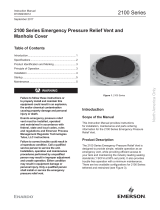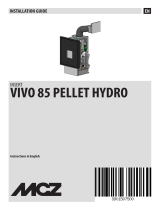Page is loading ...

Models A, A-L, 110-PO and 200
Dead Weight Hatches
Table of Contents
Introduction ............................................................................ 1
Specifications ........................................................................2
Principle of Operation ............................................................2
Installation .............................................................................2
Maintenance ..........................................................................3
Parts Ordering .......................................................................3
!
WARNING
Failure to follow these instructions or to
properly install and maintain this equipment
could result in an explosion, re and/or
chemical contamination causing property
damage and personal injury or death.
Enardo dead weight hatch must be installed,
operated and maintained in accordance
with federal, state and local codes, rules
and regulations, and Emerson Process
Management Regulator Technologies Tulsa,
LLC instructions.
Failure to correct trouble could result in a
hazardous condition. Call a qualied service
person to service the unit. Installation,
operation and maintenance procedures
performed by unqualied person may
result in improper adjustment and unsafe
operation. Either condition may result in
equipment damage or personal injury. Only
a qualied person shall install or service the
dead weight hatch.
Introduction
Scope of the Manual
This Instruction Manual provides instructions for installation,
maintenance and parts ordering information for Models A,
A-L, 110-PO and 200 dead weight hatches.
Figure 1. Model Enardo A Dead Weight Hatch
Figure 2. Model Enardo A-L Dead Weight Hatch
Figure 3. Model Enardo 110-PO Dead Weight Hatch
Figure 4. Model Enardo 200 Dead Weight Hatch
Instructional Manual
D103839X012
September 2018
Dead Weight Hatch
North America Only

Specications
The Specications section on this page provides specications for the Models A, A-L, 110-PO and 200 dead weight hatches.
Specications are stamped on the body.
Available Sizes
See Table 1
Pressure Setting
(1)
See Table 1
Vacuum Setting
(1)
See Table 1
Construction Materials
Housing: Aluminum
Lid: Aluminum or Ductile iron
Pressure/Vacuum Gasket: Buna-N or Viton
®
Hardware: Zinc-plated carbon steel
Vacuum Pallet: Aluminum
Vacuum Spring: Zinc-plated carbon steel
1. The pressure limits in this Instruction Manual and any applicable standard or code limitation should not be exceeded.
Product Description
Enardo dead weight hatches are generally used on low-
pressure, steel and berglass tanks. They provide trouble
free operation with minimum supervision. These hatches vary
in design, but their primary function is to prevent the loss of
vapors in a closed storage system and provide pressure and
vacuum relief by means of dead weight. They also provide
access and offer higher outow capacities and lower pressure
settings than standard spring-loaded hatches.
The Models A and 110-PO are dead weight pressure
relief gauge and thief hatches with round 8 in. nominal
diameter API bases. The Model A also provides vacuum
relief capacity.
The Models A-L and 200 are dead weight pressure-
vacuum relief gauge and thief hatches with 8x18 in.
and 8x22 in. oblong American Petroleum Institute (API)
bases, respectively.
Principle of Operation
When excessive pressure builds within the storage tank, the
vent’s hinged cover begins to open at the predetermined
set pressure, relieving excess pressure. When the over
pressure has dissipated, the cover reseats onto the base.
The hinge mechanism prevents misalignment and provides
an accurate reseat.
When excessive vacuum builds within the storage tank, the
spring loaded pallet lifts, breaking the seal between the seat
and pallet, allowing vapors to pass through the valve orice
relieving the vacuum buildup. The vacuum valve reseals
upon relief and remains sealed.
MODEL AVAILABLE SIZE, in. API PRESSURE SETTING, oz./sq. in. VACUUM SETTING, oz./sq. in.
A 8 2, 4 and 6 0.4
A-L 8x18 2, 3, 4 and 6 0.4
110-PO 8 1 and 2 N/A
200 8x22 1, 2, 3, 4 and 6 0.4
Table 1. Valve Setting Range
Viton
®
is a mark owned by E. I. du Pont de Nemours and Company.
Installation
CAUTION
Ensure that the tank is at atmospheric pressure
before opening. A pressure build-up inside the
tank can cause a spray to be emitted from the
hatch if opened under pressure.
1. Install the dead weight pressure vacuum hatch on a
at surface with a base gasket and an opening with a
mating API bolt pattern of 16 - 5/8 in. bolt holes on a
10 - 3/8 in. bolt circle.
2. Place the base gasket on the top of the mating bolt
pattern and align the hatch base with the gasket.
3. Insert the bolts downward into the base bolt holes
through the gasket and mounting deck. Open the hatch
and utilize the opening to gain access to the bottom of
the bolts to attach the nuts.
4. Using a socket wrench and torque wrench, tighten
the bolts in the pattern that corresponds to the pattern
shown in Figure 5.
5. Close lid.
2
Dead Weight Hatch
North America Only

Table 2. Torque Table for Flat Face Flange (Steel or Aluminum)
NOMINAL PIPE DIAMETER NUMBER OF BOLTS
BOLT DIAMETER TORQUE
In. mm Ft-lbs N•m
1 4 0.50 12.70 14 18.98
1-1/4 4 0.50 12.70 16 21.69
1-1/2 4 0.50 12.70 18 24.41
2 4 0.63 16.00 32 43.39
2-1/2 4 0.63 16.00 43 58.30
3 4 0.63 16.00 47 63.72
3-1/2 8 0.63 16.00 26 35.25
4 8 0.63 16.00 32 43.39
6 8 0.75 19.05 49 66.44
8 8 0.75 19.05 68 92.20
10 12 0.88 22.4 69 93.55
12 12 0.88 22.4 98 132.9
14 12 1.00 25.0 138 187.1
16 16 1.00 25.0 125 169.5
18 16 1.13 28.7 142 192.5
20 20 1.13 28.7 135 183.0
24 24 1.25 31.8 156 211.5
8 API 16 0.50 12.70 20 27.12
8 x 18 API 26 0.50 12.70 20 27.12
8 x 22 API 30 0.50 12.70 20 27.12
20 API 16 0.63 16.00 75 101.7
24 API 20 0.63 16.00 75 101.7
Assumptions: Use of SAE grade 5 bolts or studs or stronger.
No lubricant.
Elastomer <70 Durometer Shore A
Notes: Flat faced anges should never be mated to a raised face ange for installation.
If lubricant is used on bolts, apply torque reduction factor listed in Lubricant Table.
For best results hardened steel washers should be used on all cast ange bolted connections
DESCRIPTION COEFFICIENT OF FRICTION MULTIPLY TORQUE VALUE IN TABLE BY
Machine Oil f = 0.15 0.75
API SA2 Grease f = 0.12 0.60
Nickel-based Lubricant f = 0.11 0.55
Copper-based Lubricant f = 0.10 0.50
Heavy-duty Lubricating Past f = 0.06 0.30
Table 3. Torque Correction Factors for Common Lubricants Applied on Flanges
Note
A temporary zip tie has been installed by
the factory to secure the hatch lid during
transport. REMOVE THE ZIP TIE BEFORE
PUTTING TANK INTO SERVICE. Make sure
there is nothing else that will prevent the
lid from opening completely, as the lid is
the pressure relieving device and must be
allowed to open.
Maintenance
Perform scheduled maintenance every six months or more
frequently in corrosive or dusty atmospheres. For normal
maintenance, inspect the pressure gasket, vacuum gasket
and base gasket. Under average operating conditions,
replace the pressure and vacuum gaskets once a year.
Replace the base gasket only when a leak is noticed on
the tank deck. Continuous relieving of the hatch means that
there is a problem; closely inspect the system to determine
the cause.
Note
For parts information, refer to the catalog
data sheet on each model.
Gasket Replacement
To ensure efcient operation of all hatches, carefully wipe
the pressure and vacuum seats and gaskets every time
the hatch is opened. This prevents accumulation of residue
that can deteriorate the performance of the valves. Include
manual cycling of pressure and vacuum ports during normal
and routine semi-annual maintenance to evaluate the
condition and functionality of these relief devices during their
service lives.
3
Dead Weight Hatch
North America Only

Figure 5. Dead Weight Hatch Torque Sequence
28 30
1
5
9
13
17
21
25
3
7
11
1927
29
2
6
10
14
18
22
26
4
8
12
16
20
24
15
23
1 5 9
13
17
21
25
3
7
11
15
19
2326
10
14
18
22
26
4
8
12
16
20 24
1
5
9
3
8
12
14
2
6
10
15
4
7
11
13
16
MODEL A-L
28 30
1
5
9
13
17
21
25
3
7
11
1927
29
2
6
10
14
18
22
26
4
8
12
16
20
24
15
23
1 5 9
13
17
21
25
3
7
11
15
19
2326
10
14
18
22
26
4
8
12
16
20 24
1
5
9
3
8
12
14
2
6
10
15
4
7
11
13
16
MODEL 200
MODEL A AND MODEL 110-PO
28 30
1
5
9
13
17
21
25
3
7
11
1927
29
2
6
10
14
18
22
26
4
8
12
16
20
24
15
23
1 5 9
13
17
21
25
3
7
11
15
19
2326
10
14
18
22
26
4
8
12
16
20 24
1
5
9
3
8
12
14
2
6
10
15
4
7
11
13
16
Vacuum Gasket
1. The vacuum gasket for a dead weight hatch is located
under the cap on the lid of the hatch. Remove the cap by
unscrewing the attachment screws.
2. The gasket is secured to the vacuum disk with a sip t
under the retainer. Remove the gasket and replace with
the new one by stretching the gasket and slipping it into
the retainer.
3. Replace the vacuum disk and resecure the lid with the
attachment screws.
Pressure Gasket
1. The pressure gasket is the sponge gasket in the ring
groove on the underside of the lid that seats against
the base lip. The old gasket can be removed by peeling
it from underneath the groove. Thoroughly clean the
groove and apply a small amount of rubber adhesive.
2. Fit the new gasket under the groove by slowly moving
the gasket into the groove around the lid until the
ends of the gasket meet. Cut in a diagonal way so that
the ends do not meet at a 90 degree angle. Replace
only with Enardo replacement gaskets as the gasket
material is specially designed for hatch service and not
commonly available.
Parts Ordering
When corresponding with your local Sales Ofce about this
equipment, always reference the equipment serial number
that can be found etched on the body.
Dead Weight Hatch
Facebook.com/EmersonAutomationSolutions
LinkedIn.com/company/emerson-automation-solutions
Twitter.com/emr_automation
Enardo.com
D103839X012 © 2015, 2018 Emerson Process Management Regulator
Technologies, Inc. All rights reserved. 09/18.
The Emerson logo is a trademark and service mark of Emerson
Electric Co. All other marks are the property of their prospective owners.
Enardo™ is a mark owned by Regulator Technologies Tulsa, LLC, a
business of Emerson Automation Solutions.
The contents of this publication are presented for informational purposes
only, and while every effort has been made to ensure their accuracy,
they are not to be construed as warranties or guarantees, express or
implied, regarding the products or services described herein or their use
or applicability. We reserve the right to modify or improve the designs or
specications of such products at any time without notice.
Emerson Process Management Regulator Technologies
Tulsa, LLC does not assume responsibility for the selection, use or
maintenance of any product. Responsibility for proper selection, use
and maintenance of any Emerson Process Management Regulator
Technologies Tulsa, LLC product remains solely with the purchaser.
North America Only
Emerson Automation Solutions
Americas
McKinney, Texas 75070 USA
T +1 800 558 5853
+1 972 548 3574
Tulsa, OK 74146 USA
T +1 918 662 6161
Europe
Bologna 40013, Italy
T +39 051 419 0611
Asia Pacic
Singapore 128461, Singapore
T +65 6777 8211
Middle East and Africa
Dubai, United Arab Emirates
T +971 4 811 8100
/










